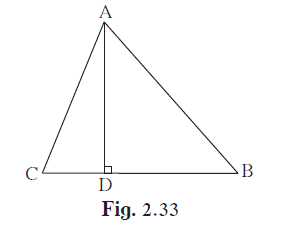In ∆ABC, seg AD ⊥ seg BC, DB = 3CD. Prove that: 2AB2 = 2AC2 + BC2
Chapter 2 – Pythagoras Theorem- Text Book Solution
Problem Set 2 | Q 13 | Page 45
In ∆ABC, seg AD ⊥ seg BC, DB = 3CD.
Prove that: 2AB2 = 2AC2 + BC2

In ∆ABC,
AD ⊥ BC, and BD = 3CD ...(Given)
BC = CD + DB
∴ BC = CD + 3CD
∴ BC = 4CD
CD = `1/4` BC ...(1)
and, BD = `3/4` BC ...(2)
In ∆ADC,
∠ADC = 90°
by Pythagoras' theorem,
AC2 = AD2 + CD2
AD2 = AC2 - CD2 ...(3)
In ∆ADB,
∠ADB = 90°
by Pythagoras' theorem,
AB2 = AD2 + BD2
AB2 = AC2 - CD2 + BD2 ...[From 3]
`"AB"^2 = "AC"^2 + (3/4"BC")^2 - (1/4 "BC")^2` ...[From equation (1) and (3)]
`"AB"^2 = "AC"^2 + (9"BC"^2 - "BC"^2)/16`
`"AB"^2 = "AC"^2 + (8"BC"^2)/16`
`"AB"^2 = "AC"^2 + 1/2 "BC"^2`
Thus, 2AB2 = 2AC2 + BC2
Explanation:-
In right angled triangle ADB, applying Pythagoras theorem, we get:
AB^2 = AD^2 + DB^2
In right angled triangle ADC, applying Pythagoras theorem, we get:
AC^2 = AD^2 + CD^2
Adding the above two equations, we get:
AB^2 + AC^2 = 2AD^2 + DB^2 + CD^2
We need to express DB and CD in terms of BC.
From the given condition, we have:
DB = 3CD
Therefore, CD = DB/3
Also, since AD is perpendicular to BC, we have:
AD^2 = BD * DC
Substituting the values of CD and DB, we get:
AD^2 = (3CD) * CD = 3CD^2
Substituting these values in the above equation, we get:
AB^2 + AC^2 = 2(3CD^2) + DB^2 + CD^2
Simplifying this equation using the given condition, we get:
AB^2 + AC^2 = 8/3(DB^2 + CD^2)
But we also know that:
DB^2 + CD^2 = BC^2
Substituting this value, we get:
AB^2 + AC^2 = 8/3(BC^2)
Simplifying, we get:
2AB^2 = 2AC^2 + BC^2
Hence, we have proved that 2AB^2 = 2AC^2 + BC^2, given that in triangle ABC, AD is perpendicular to BC and DB is three times as long as CD.
Chapter 2 – Pythagoras Theorem- Text Book Solution
Problem Set 2 | Q 13 | Page 45
